Heel pain in kids is an increasingly common complaint amongst the youngsters of today’s 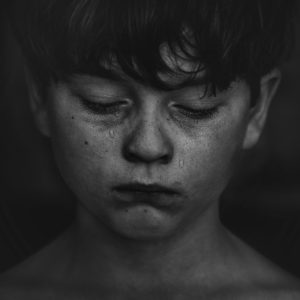 society. Often times parents will mistakenly contribute this type of pain to merely “growing pains” and either ignore their child’s cries OR wait to implement treatment believing that this pain will eventually “go away” on its own.
society. Often times parents will mistakenly contribute this type of pain to merely “growing pains” and either ignore their child’s cries OR wait to implement treatment believing that this pain will eventually “go away” on its own.
In this article, I will examine heel pain in kids via discussing the symptoms, difference of this pain in adults versus children, causes, diagnostic modalities, treatment options, and prevention.
Common Signs & Symptoms of Heel Pain in Kids
For clarification purposes, I feel it is essential to state that heel pain is NOT a diagnosis nor disease within itself, but rather a symptom. Having this pain potentially indicates that an underlying disease or injury exists.
When a child complains of heel pain, this should alert the parent that a condition is present that deserves their attention.
Signs and symptoms commonly associated with heel problems in children include:
- Pain in the bottom or back of the heel
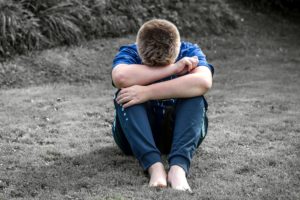
- Walking with a noticeable limp
- Toe-walking or walking on the toes with body weight lifted off of the heels
- Increasing desire to sit and “rest” when walking normal, everyday distances
- Decreasing desire and difficulty participating in usual sporting events and/or activities.
The Difference Between Heel Pain in Kids & Adults
The unknowing parent may inaccurately self-diagnose their child’s heel pain as a condition called Plantar Fasciitis. With a simple google of “heel pain”, hundreds of articles will discuss Plantar Fasciitis as the most common cause of heel pain. However, there is a HUGE difference regarding the cause of heel pain in kids versus that of adults.
Plantar Fasciitis, usually seen in adults, results in pain within the heel that is most prevalent on the first step out of bed in the mornings or when taking a step after an extended period of sitting down. This pain typically improves in intensity upon walking short distances.
Oppositely, heel pain in kids usually feels better after rest and the intensity of the pain is noticed to increase upon walking and activity.
Why is this?
A child’s bones have what we call growth plates, also known as the epiphysis. This area is the location that new bone forms as the child grows until the particular bone reaches its adult size.
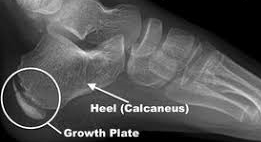
The epiphysis of the calcaneus (heel bone) is an area that doesn’t fully develop until a child is around 14 years of age or older. This growth plate is located on the back of the heel and is very weak until it becomes adult-sized.
Excessive stress on this area of the heel bone is the primary cause of heel pain in kids.
Causes of Heel Pain in Kids
Because there are a multitude of causes of heel pain in kids and the diagnosis can be quite challenging, a visit to a podiatric physician (like myself) is recommended to determine the cause of the pain and implement an effective mode of treatment.
Some of the most common causes of pediatric heel pain include the following conditions.
Sever’s Disease
Also referred to as Calcaneal Apophysitis, Sever’s Disease is the #1 cause of heel pain in kids.
Misidentified as a “disease”, this condition is actually a result of inflammation occurring within the growth plate of the heel bone. This inflammation is commonly witnessed in our young athletes or obese children due to repetitive stress and muscle strain to the area before the calcaneus (heel bone) is fully formed.
Calcaneal Apophysitis can occur in both feet or just one foot.
 The signs and symptoms associated with this condition tends to include some or all of the following:
The signs and symptoms associated with this condition tends to include some or all of the following:
- Tenderness and pain along the back of and/or bottom of the heel when ambulating
- Pain or tenderness upon a simple touch to the heel that increases when the heel is squeezed
- Pain in the heel that is intensified by activity and improves with rest
- Swelling or redness in one or both heels
- Ambulating with a limp or toe-walking (walking on tip toes)
If interested in learning more about Sever’s Disease, please visit the following two links:
Sever’s Disease in Children – Is it Affecting Your Child’s Game?
How to Treat Heel Pain – Get Back in the Game
Tendo-Achilles Bursitis
There is a natural bursa, fluid-filled sac, located directly between the back of the heel bone and the Achilles Tendon (heel cord). Certain things can cause this bursa to become inflamed. When this occurs, we refer to the condition as Tendo-Achilles Bursitis.
The inflammation of this particular bursa can be a result of multiple scenarios including, but not limited to, direct injury to the heel, inflammatory diseases (such as Juvenile Rheumatoid Arthritis), or even simply wearing shoes that are poorly cushioned where the shoe touches the back of the heel.
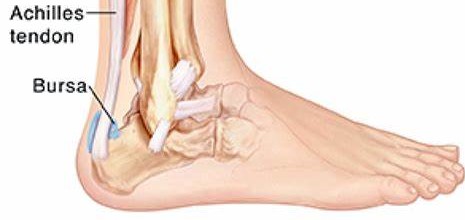 Symptoms frequently seen with Tendo-Achilles Bursitis can include the following:
Symptoms frequently seen with Tendo-Achilles Bursitis can include the following:
- Tenderness and pain isolated to the back of the heel
- Pain along the back of the heel that is intensified by walking, running, or standing on tip-toes
- Warmth and/or area of redness seen on the skin on the back side of the heel area
- Pain along the back of the heel that is aggravated by wearing shoe gear that rubs the particular area the pain is present
Achilles Tendonitis
Achilles Tendinitis is a condition that we often term as an “overuse syndrome”.
This diagnosis often results in those over the age of 14 (heel bone is fully developed) and is caused by the repetitive nature of running and pounding on hard surfaces usually in sports such as basketball, soccer, and track among others.
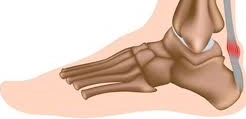 Symptoms associated with Achilles Tendinitis include some or all of the following:
Symptoms associated with Achilles Tendinitis include some or all of the following:
- Pain just above the back of the heel and lower portion of the leg
- Pain that intensifies with activity and pointing of the toes and improves with rest and the foot in a relaxed state
- Soreness and stiffness in the back of the heel area that is worse upon rising in the morning
- Pain along the back of the heel that is aggravated by wearing shoegear that rubs the back-side of the heel.
Plantar Fasciitis
Also categorized as an “overuse syndrome”, Plantar Fasciitis is most commonly seen in adults, but can be seen in children, typically over the age of 14.
The plantar fascia band is a band of tissue that spans the bottom of the foot from the heel all the way to the toes. When this band becomes inflamed, usually due to obesity or overuse, this is termed Plantar Fasciitis.
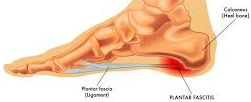 Symptoms frequently seen with Plantar Fasciitis may include some or all of the following:
Symptoms frequently seen with Plantar Fasciitis may include some or all of the following:
- Sharp pain on the bottom of the heel
- Pain on the bottom of the heel is most intense on the first step out of bed in the morning and improves some upon walking a bit
- Pain that increases when standing for extended periods of time
Fractures
Heel pain in kids may also be the direct result of a fracture (break in the bone). There are two types of fractures (stress fracture and acute fracture) that should be ruled out when heel pain exists.
Stress fractures are typically witnessed in athletic adolescents whom suddenly undergo a change in the level of intensity of workouts.
Acute fractures are seen in a direct injury to the area. Pain and swelling can be immediately correlated to the time of injury.
Diagnosis of Pediatric Heel Pain
A visit to your local podiatrist or other medical professional is essential to diagnose the underlying cause of heel pain in your child.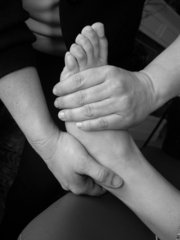
The examination will begin with questions surrounding your child’s recent activity as well as their medical history. A thorough physical exam of the foot in its entirety as well as the leg will then ensue. Radiographs (x-rays) will often follow and will be utilized to evaluate the bones and structure of the foot as well as to determine the maturity of the bones and whether growth plates are still open.
In some cases, additional studies such as an MRI (Magnetic Resonance Imaging), CT Scan (Computerized Tomography), bone scans, or laboratory testing may be ordered or performed to further assist an accurate diagnosis for the heel pain.
Treatment Options for Heel Pain in Kids
Obviously, the treatment for pediatric heel pain needs to be approached in a manner that eliminates, adjusts, or fixes the root cause of the pain.
Most of the time, treatment modes for heel pain in kids is approached by the level of intensity of the pain and broken down into categories of mild, moderate, and severe pain.
Mild Heel Pain in Kids
- Reduction in Activity. Immediately stop or reduce whatever activity is generating the pain until the pain no longer exists.
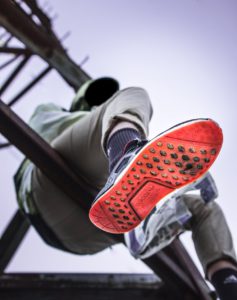
- Heel Cushions. Implement an added cushion within the shoe which will soften the impact upon the heel when walking or participating in activities. I have found the most success and my pediatric patients rant and rave over the Tuli’s Heavy Duty Heel Cups!
Moderate Heel Pain in Kids
With moderate heel pain, you will want to execute the treatments listed above for mild heel pain in addition to the following recommendations.
- Medication. Administer ibuprofen or other oral NSAIDs (Nonsteroidal Anti-Inflammatory Drugs) to aid in the reduction of pain and inflammation.

- Physical Therapy. Stretching exercises and/or other modalities of physical therapy may be utilized in order to promote healing of the area(s) of inflammation. Icing the area is a very beneficial form of physical therapy although the heel is a hard area to adequately ice. The ProIce Ankle/Foot Ice Therapy Wrap makes icing the heel a breeze and is what I, personally, recommend to my patients.
- Orthotics. Often times orthotic devices that are prescribed by your podiatrist and are custom-made for your child’s foot are recommended. The goal behind the use of orthotics is to provide support for the feet and redistribute the ground reaction forces that act upon the joints of the feet while weight-bearing.
Severe Heel Pain in Kids
- Immobilization. Sometimes, with severe heel pain, aggressive measures such as
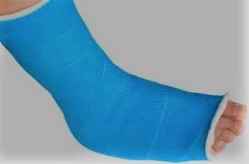 immobilization of the area needs to be implemented in order for the condition to fully resolve. Immobilization may entail either becoming non-weightbearing via the use of crutches or casting. Following the immobilization period, orthotic devices and/or physical therapy modalities are usually implemented to ensure the condition does not return.
immobilization of the area needs to be implemented in order for the condition to fully resolve. Immobilization may entail either becoming non-weightbearing via the use of crutches or casting. Following the immobilization period, orthotic devices and/or physical therapy modalities are usually implemented to ensure the condition does not return.
- Surgery. While uncommon, there are times when surgical correction is recommended. This is typically reserved for structural abnormalities within the foot and/or the tendons within in.
For more specific information regarding the treatment of heel pain, feel free to go to my article titled “How to Treat Heel Pain – Get Back in the Game“.
Prevention of Heel Pain in Children
While nothing can 100% guarantee that your child will never develop heel pain, there are certain actions that can be taken to be proactive and minimize their risks.
Some ways to prevent adolescent heel pain include the following:
- Avoid childhood obesity
- Purchase shoegear that is well-constructed and provides support to the feet
- For athletes – Ensure that shoegear worn is appropriate for the particular sport or activity and limit the amount of time that cleated shoes are worn
- Do not push your child above and beyond their individual physical ability
Take Away on Heel Pain in Kids
Typically, it is the nature of a child to be active and desire to participate in extra-curricular 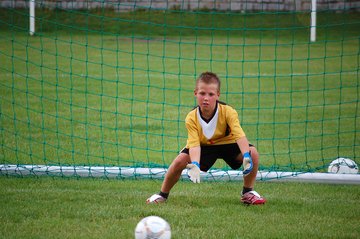 events.
events.
When an adolescent complains of heel pain and it becomes evident that this heel pain is beginning to influence their participation in the usual activities, it is time to take action to determine the cause of the pain and implement the appropriate treatment.
Heel pain in kids is nothing to be ignored and with the proper diagnosis and treatment modalities, a parent can easily have their child pain-free and enjoying life again.
I sincerely hope that you found my article informative and that it will help you to alleviate your child’s heel pain.
If you have ANY questions, or even personal experience with heel pain involving your kids, please feel free to comment below. I am here to help!
Your Online Foot Expert,
Dr. Misty
Podiatric Physician and Owner/Creator of FixUglyNails.com
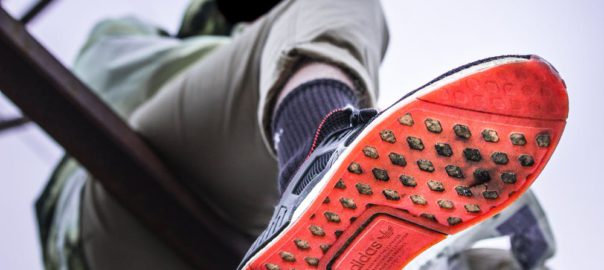
Thabk you doctor, you have quite a good amount of knowledge on the topic. I have a sister who has pain in her heels like you have spoken about here. She is pretty active in sports at her school. I try to rub it with balm and make her rest some and it decreases, but once she gets active again, it returns. I can’t stop her from what she loves doing like you mentioned, but I’ll try to get that gear to suppress the pain. Thank you for the valuable information that is contained in the content of this post. I enjoyed learning from you.
Hello Henderson. I want to begin, by saying that I am so sorry that your sister is experiencing this type of pain. I know that it really can hurt. I would like to direct you to my article title “How to Treat Heel Pain – Get Back in the Game“. It goes in to great detail on more that you can do for your sister to get her feeling better fast. Let me know if you have any additional questions… I LOVE what I do and am truly here to help.
Thanks so much for providing this much information about heel pain in kids and the possible causes. My kid came home from school yesterday complaining of heel pain and he was even crying. I have tried to relieve him from the pain but it seems it is all trial and error. Thanks so much for giving all these ways to treat it. I will surely start some of your recommendations now. I’m grateful for the help provided through this post
Hello Roland. I am so sorry that your child is experiencing this type of pain. I would like to direct you to my article “How to Treat Heel Pain – Get Back in the Game“. This will provide you with even more great treatment recommendations in order to nip it in the bud. Let me know if you have any additional questions. I truly am here to help!
As a lad, I used to live with heel pain. I thought that this was because of a surgery that I had when I got injured on the pitch. I didn’t want to stop playing football so I continued and, with time, it really kept hurting me. I had to reduce the amount of time that I played football and with time, the pain disappeared. It’s good to see that you are here trying to help others deal with this situation. It was good to devour this post.
Good afternoon John. I am sorry that you sufferred with heel pain as a child. It was probably cause by a condition called Sever’s Disease. As the article above states, this is the #1 cause of heel pain in kids. I am glad that with rest you finally got over it. It is absolutely my goal to educate others and help them get through many conditions involving the feet. Please let me know if you ever have any questions.
Hi, Dr. Misty.Excellent article for parents awareness on their children’s pain complaints. It’s good to know about sign and symptoms of heel pains, the causes and seriousness of it. Your advices on how to prevent kids heel pain such as avoiding obesity and the type of shoes to wear are really open eyes to me. We want our kids to do well in their lives and practice at least one sport but certainly with precaution. I’m glad I found your website because I myself know what it is to have pain on the feet suffering with osteoarthritis condition therefore I’ll be visiting your site to learn more about how to deal with health condition on the feet. Thanks
Hello Fany! Thank you for the kind words! I do have another article entitled “How to Treat Heel Pain – Get Back in the Game” in which I go into a bit more detail on the treatment of heel pain in kids. Feel free to review at your leisure. In addition, I have some new articles coming out soon (one of which deals with osteoarthritis) that you may find beneficial. Just let me know if you have any questions… I am truly here to help!
Hi, Dr. Misty. Excellent article for parents awareness on their children’s pain complaints. It’s good to know about sign and symptoms of heel pains, the causes and seriousness of it. Your advices on how to prevent kids heel pain such as avoiding obesity and the type of shoes to wear are really open eyes to me. We want our kids to do well in their lives and practice at least one sport but certainly with precaution. I’m glad I found your website because I myself know what it is to have pain on the feet suffering with osteoarthritis condition therefore I’ll be visiting your site to learn more about how to deal with health condition on the feet. Thanks
Hello Fany! I hope your afternoon is going well. Thank you for visiting my platform and your comment surrounding my article on heel pain in kids. Pain in the feet, at any age, is not fun. I apologize that you know this first-hand in dealing with osteoarthritis. I should have an article on this condition coming out soon! Keep your eyes peeled! Also, feel free to comment at any time on any page if you ever have any questions regarding your feet that you are needing answered.
Excellent article on Heel Pain in Kids. Your post is awesome and educative. Heel pain in kids can be very disturbing because it is often hard for children to describe how severe the pain is. The prevention tips here are very important because prevention is easier than curing. All parents should follow your prevention tips in order to keep our kids from heel pain suffering. Thank you for sharing this helpful write-up.
Hello Abayomi and thank you for your kind comment. I definitely agree with you in that incorporation of the prevention strategies early is far easier than waiting until heel pain has developed in kids and treating it. Should you have any questions regarding this, or anything else foot related, please feel free to come back and comment. I am here to help.
It was refreshing to read an article related to medical matters from a licensed medical practitioner. I had not heard of heel pain in kids as you have described. You explained the causes and possible treatments very clearly. I wish that parents who have kids get a chance to read this very informative article.
Do you also take care of joint pains in adults like those caused by arthritis? If you do, an article about that would be very helpful. I suffer from that condition to my left knee and it can be so debilitating.
Thanks for writing this article.
Edwin
Edwin… good afternoon and thank you for your visit to my site. I am thrilled that you found my presented information informative. I do treat a multitude of patients for arthritic conditions. Stay tuned… an article on this subject matter will be up soon. Just feel free to let me know if you have any questions! ((: